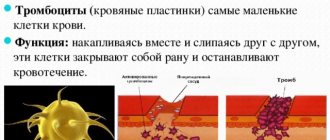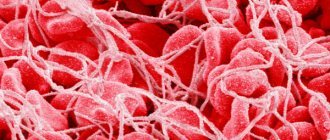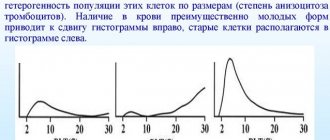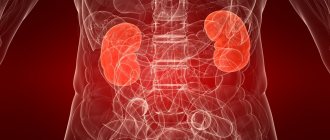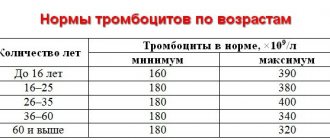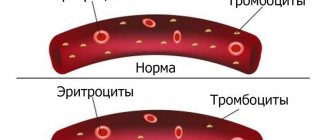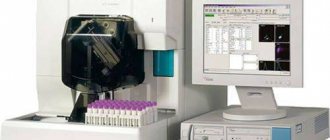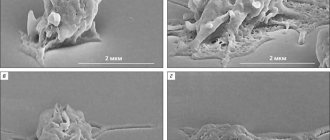History tells us that even in ancient Rome and Egypt, healers used bloodletting as one of the main methods of treatment. Over the years of medical development, this method has been seriously transformed and is currently used in the form of plasma cytapheresis.
What is thrombocytapheresis
Help: the spelling “thrombocytopheresis” is incorrect. Correct: “thrombocytapheresis”, however, spellings that do not comply with the norms of the Russian language are more common.
Thrombocytapheresis is a procedure for isolating individual components (in this case platelets) from donor blood for subsequent transfusion of platelet mass to the recipient, making special blood products, etc. Sometimes it is carried out for therapeutic purposes - in cases where it is necessary to reduce the level of platelets in the patient’s bloodstream , a certain number of cells are removed using a similar procedure.
Platelets are taken into a separate reservoir, and other blood cells are returned to the donor's blood
The procedure can be carried out in two ways: in accordance with the characteristics of its implementation, plateletpheresis is divided into intermittent and instrumental. In the first case, a certain amount of blood is taken from the donor, processed using a centrifuge, and after the necessary components are isolated, it is returned back. The hardware method is more complex and expensive - it involves the use of a special device called a blood cell separator, which releases platelets directly during the procedure.
If we are talking about the quality of platelet mass, then there is no significant difference between the methods of obtaining it, but for donors the hardware method is considered more expensive, since in order to donate blood they have to visit a medical facility several times.
Who can become a blood donor - a list of absolute and temporary contraindications to donation
If you ever thought that any of us could become a donor, because every drop of blood is worth its weight in gold, do not rush to run to the blood transfusion center! First, look at your medical record: if you have at least one of the diseases listed below, the road to saving other lives is closed to you forever.
Absolute contraindications to donation of blood and its components (refusal from donation regardless of the duration of the disease and treatment results):
1. Blood-borne diseases, namely:
- Infectious diseases , such as AIDS, HIV carriers, as well as risk groups - drug addicts, people with non-traditional sexual orientation and those who are promiscuous; syphilis, viral hepatitis, tuberculosis and others.
- Parasitic , such as toxoplasmosis, echinococcosis and others.
2. Somatic diseases, namely:
- Malignant neoplasms.
- Organic diseases of the central nervous system.
- Blood diseases.
- Mental illnesses .
- Alcoholism and drug addiction.
- Cardiovascular diseases such as coronary disease, atherosclerosis, hypertension, heart disease and others.
- Respiratory diseases such as bronchial asthma, emphysema and others.
- Diseases of the digestive system, such as gastritis, peptic ulcer.
- Eye, skin diseases, as well as diseases of the ENT organs, liver, kidneys, connective tissue and many others.
Temporary contraindications to donating blood and its components:
- Drinking alcohol is prohibited for 48 hours.
- Blood transfusion – withdrawal for 6 months.
- Surgical interventions – withdrawal for 6 months.
- Foreign business trips lasting more than 2 months - allotment for 6 months.
- Contact with patients with hepatitis – disqualification for a period of 3 months to 1 year.
- Tattooing or acupuncture procedures are valid for 1 year.
- Past infectious diseases - withdrawal for a period of 1 month to 1 year.
- The period of pregnancy and lactation is set aside for 1 year after childbirth or 3 months after the end of lactation.
- Vaccinations are valid for a period of 10 days to 1 year.
- Stay in malaria-endemic countries of tropical and subtropical climates - allotment for 3 years.
You can find a complete list of absolute and temporary contraindications to blood donation in Appendix 2 to the Procedure for medical examination of a blood donor and its components (List of contraindications), Order of the Ministry of Health of the Russian Federation dated September 14, 2001 N 364.
On a note! If the donor has diseases not included in the presented list, the issue of admission to donation is decided by a commission by a transfusiologist and relevant specialists. It is also interesting that in Russia there are much more stringent requirements for blood donors than in other countries. What causes this state of affairs is not completely clear, and as usual, the coin has two sides: on the one hand, a good incentive for Russians to lead a healthy lifestyle and eat right, on the other, a noticeable decrease in the number of blood donations due to the inadequacy of the health of those wishing to become donors submitted to the requirements of the Ministry of Health.
Indications for use
Indications for platelet transfusion include:
- low level of platelets in the blood (thrombocytopenia), which is observed in some autoimmune and endocrine disorders, as well as in disorders of the hematopoietic system;
- insufficient cell quality, which leads to poor blood clotting and frequent bleeding;
- hemostasis disorders (DIC syndrome, etc.);
- uncontrolled bleeding from the mucous membranes of the mouth and nose, uterus;
- extensive blood loss due to surgery or serious injury;
- damage to muscles, tendons and other tissues (in cases where it is necessary to accelerate their recovery).
In cosmetology, the plateletpheresis procedure is used for baldness, serious skin problems and other pathologies. Platelets are obtained from the patient's own blood, after which the resulting drug is administered using a syringe.
For therapeutic purposes, plateletpheresis is performed after removal of the spleen, for atopic dermatitis, bronchial asthma and other conditions that are accompanied by significant thickening of the blood due to an increase in platelet concentration.
What is thrombocytopheresis
Ancient bloodletting was a real release of blood without seizures. Gradually, the science of blood composition made it possible to isolate plasma and formed elements ( erythrocytes , platelets ).
At some point in time, researchers came to the conclusion that not all cases should be released whole blood, since often it is necessary to get rid of part of either the plasma or the formed elements.
The concept of apheresis was introduced from the English apheresis (extraction), which in medicine means a method of physically isolating blood components (this term is also used for bone marrow). To perform the procedure for isolating components, centrifugation is used. Special centrifuges with a filter system have been developed that are capable of separating the necessary components into a separate mass.
To understand exactly what is released during centrifugation, the terms cytapheresis (often said cytopheresis), which involves the separation of formed elements, and plasmapheresis, which specifically refers to the separation of blood plasma, were introduced.
In the medical literature, cytapheresis is mentioned as a therapeutic method as an extracorporeal blood separation in which pathologically altered cells are selectively removed.
In this article we consider only thrombocytopheresis (by the way, it would be more correct to say thrombocytapheresis, but they say both ways), in which platelets are released. An example is the increase in platelet levels in chronic myeloid leukemia. In this case, we just need to rid the patient of their elevated levels, that is, remove excess from the blood.
It is believed that the impetus for improving cytapheresis was given by hospital medicine during the Second World War. To treat the wounded, large supplies of whole blood were needed, which could not be stored for long. But the duration of storage of blood plasma and formed elements separately is many times higher.
Gradually, the procedure of simple bloodletting, that is, removal of unnecessary elements, turned out to be applicable in the donor business.
The term “donor plateletpheresis” appeared, which implies the procedure of transfusion of not whole blood, but only blood cells (in this case, specifically platelets). For reference. Today, donor thrombocytopheresis is used as a component in the treatment of many autoimmune and hormone-dependent diseases. However, simple collection of donor platelets is widely used at blood transfusion stations. The collected platelet mass is used in the manufacture of blood substitutes and blood products.
Indications for use
Note that a pure “transfusion” of platelets is necessary for:
- thrombocytopenia – reduced concentration of platelets in the blood;
- thrombasthenia – insufficient functioning of platelets, which causes bleeding;
- thrombophilia - a predisposition to the formation of blood clots;
- DIC syndrome - a blood clotting disorder;
- local bleeding (in the uterus, organs of the digestive system, kidneys, bladder);
- frequent spontaneous bleeding from the nose or mucous membranes of the mouth;
- heavy bleeding caused by surgery.
Contraindications
Platelet mass can be a real salvation for people with blood clotting problems
Thrombocytapheresis is considered a difficult procedure for both the donor and the recipient, therefore there are a number of contraindications to its implementation:
- childhood;
- exhaustion, poor physical shape (adult weight below 50 kg);
- disorders of the cardiovascular system;
- severe systemic diseases (tuberculosis, HIV, AIDS);
- any chronic diseases;
- oncology;
- allergic manifestations;
- presence of tattoos or piercings;
- history of organ transplantation;
- alcoholism, drug addiction, promiscuity;
- mite infestation;
- hepatitis and severe liver dysfunction.
What is hepatitis C and how to detect it at an early stage:
Relative contraindications include menstruation and pregnancy in women, as well as infectious and inflammatory processes in the body. If any infection or inflammation is detected in a potential donor, it is necessary to undergo appropriate treatment, and then undergo a medical examination again - depending on its results, a decision is made on the possibility of collecting platelets.
Donor requirements
Donating blood for platelets is a complex procedure using a special apparatus that lasts two to three hours. This fact makes it necessary to present increased requirements to donors.
Only a completely healthy person can become a platelet donor
The following persons cannot be donors:
More article:Is it useful to donate blood to women?
- under 18 years of age and over 50;
- having a body weight of less than 50 kg;
- pregnant and lactating women;
- drinking alcoholic beverages during the last 2 days;
- those who had tattoos or piercings, underwent surgery or vaccination less than six months ago;
- after a concussion;
- having transplanted organs and oncological pathologies;
- leading an immoral lifestyle (alcoholics, drug addicts);
- susceptible to diseases of the cardiovascular system, HIV infection, AIDS, allergic reactions, tuberculosis, asthma, ulcerative lesions, hepatitis;
- suffering from viral, inflammatory, as well as any chronic and acute pathologies, as well as malfunctions of the coagulation system;
- having mental pathologies, hearing, vision and speech impairments;
- undergoing drug therapy.
Also, platelet mass cannot be donated by women during menstruation.
The attending physician may not allow you to donate platelets for other reasons, providing reasons for his refusal.
Preparation
Before the procedure, the donor is required to undergo a comprehensive examination, which includes tests for severe infections, a general and biochemical blood test (sometimes additional tests are required), as well as an external examination, after which he is given an appropriate conclusion. If the specialist has given permission to perform plateletpheresis, the donor will need to comply with the following rules:
- for 14 days before platelet collection, stop using any medications;
- for 5–7 days, avoid alcoholic beverages and, if possible, avoid exposure to excessive physical and psycho-emotional stress;
- the day before blood sampling, stop smoking and get proper rest.
What to do if there is alcohol in your blood? More details:
In addition, you should pay attention to the diet: it should be nutritious and as balanced as possible, including all the substances necessary for the body. Consumption of semi-finished products, salted, smoked and pickled foods, as well as fatty foods, citrus fruits and whole milk should be kept to a minimum.
If the procedure is carried out using a hardware method, which is more difficult to tolerate than intermittent, additional requirements will be imposed on donors.
- Some donation experience and normal tolerance to procedures related to blood collection - a person must have at least three donations in the past 6 months.
- Body weight is at least 65–70 kilograms, normal BMI index (no weight deficit relative to height).
- Good venous access is sufficient lumen of the veins that can ensure normal blood flow.
- Normal blood pressure and the functioning of the cardiovascular system - people with a tendency to a sharp decrease in blood pressure are not allowed to undergo hardware plateletpheresis.
Another prerequisite is good health: if the donor feels the slightest discomfort, he must inform the doctor about it, otherwise donation may result in serious health problems.
What is chyle?
In the results of medical blood tests, the term “chylosis” is sometimes found. To a person far from medicine, it may seem like the name of a terrible disease. In fact, chyle is a pathological condition characterized by an increased amount of triglycerides (neutral fats). Chylosis can be diagnosed in people of both sexes, at any age and does not depend on the physical form and condition of the patient. The amount of triglycerides changes throughout the day. It increases significantly after eating, and decreases to its minimum only after 10-12 hours. It is for this reason that the donor’s diet before donation should be special, and blood tests should be taken on an empty stomach. The most effective prevention of chylosis is to avoid alcohol and fatty/heavy foods for three days. If the diet is followed, the blood test of the potential donor will be good and he will be allowed to donate.
How to do it
The plateletpheresis procedure is simple, but takes a long time - at least 1.5–2 hours. At the appointed time, the donor comes to the medical facility, sits in a comfortable chair, his arm is fixed, and a needle is inserted into the vein. A special tube is put on its end, which is connected in series to the device and another needle. The second needle is inserted into the donor's second arm, and the preparatory stage is considered complete. After the device is started, the blood from the body will be transfused into a centrifuge and separated there into separate fractions, with the platelet mass entering a separate reservoir, and the rest returning back.
The only condition for the donor is to keep his hand relaxed so that the needle does not fall out of it. During the procedure, you can read, watch TV, work on mobile gadgets, etc. After its completion, a bandage is applied to the donor's hand, he is given tea with sugar and a bar of chocolate, after which the person can go home. You can undergo plateletpheresis no more than once a month.
There is also a set of rules and the sequence of blood donation that the donor must follow:
Stages of donating platelets and the essence of the procedure
Platelet donation can be carried out intermittently and by hardware.
In the first case, blood is taken from the donor, platelets are then isolated from it using a centrifuge, and infused back into the human body. The duration of the procedure depends on the rate at which the required number of blood platelets is collected, which, in turn, is affected by the weight of the donor. This technique is used in rare cases due to its duration and complexity.
In hardware plateletpheresis, special units are used that have the ability to continuously centrifuge blood. They allow the healthcare professional to monitor the speed of the procedure and the person’s condition. Typically, Dideco-Exel, Amikus, and Baxter equipment is used.
The non-contact operating principle of the system makes the manipulation absolutely sterile.
The device is controlled using a computer with all information about the manipulation displayed on its monitor
After passing the necessary tests and receiving permission from the doctor:
- The donor sits in a comfortable chair, his arm is fixed.
- A special sterile tube is connected to the device at one end. A sterile needle is placed on the other side and inserted into the vein.
- An identical manipulation is carried out with the second hand.
- One tube carries the blood into the machine, where platelet mass is released. The return of the treated blood to the other arm is carried out through a second hose.
- After manipulation, the donor is given bandages at the puncture site, which cannot be removed for several hours. In addition, they give you strong tea to drink and chocolate to eat. If dizziness occurs, you should rest or seek help from a nurse.
Please note that a one-time blood draw should not exceed 500 ml. Obtaining a sufficient number of platelets is achieved by distilling the blood several times, which significantly increases the duration of the manipulation. So, if a typical blood donation does not exceed 15 minutes, plateletpheresis can last more than two hours.
The isolated platelet mass (orange-brown) is collected and stored in sealed bags for no more than 5 days with regular stirring to avoid the formation of clots.
Feedback on the procedure and its tolerability
I also underwent the procedure of hardware plateletpheresis two years ago.
not scary, not painful. after passing, drink some good red wine, eat red meat lala4ka https://yarportal.ru/topic187076.html
I donated platelets, so the tests and platelet donation were on different days. I took the test at my place of work, so there were no difficulties for me. For a working person this is, of course, problematic. But the donor is given a certificate for work to give him tests and blood. The donor has the right to a day off on the day of blood donation and an additional day off at any time convenient for him! The procedure itself for collecting blood and its components is, of course, not the most pleasant, especially if the donor is very worried. Fainting is only from nerves! During the plateletpheresis procedure, a reaction to sodium citrate (an anticoagulant that prevents blood from clotting in the tubular system) is possible, but the doctor quickly neutralizes this reaction of the donor’s body by administering calcium gluconate. It's okay too. But if you have a severe reaction, if I were you, I wouldn’t donate platelets often. After the procedure you may feel weak. You need to drink more fluids on this day, eat well, do not exercise, do not go to the bathhouse/sauna. In addition, research has proven that it is useful for men to donate whole blood - this prevents blood clots


